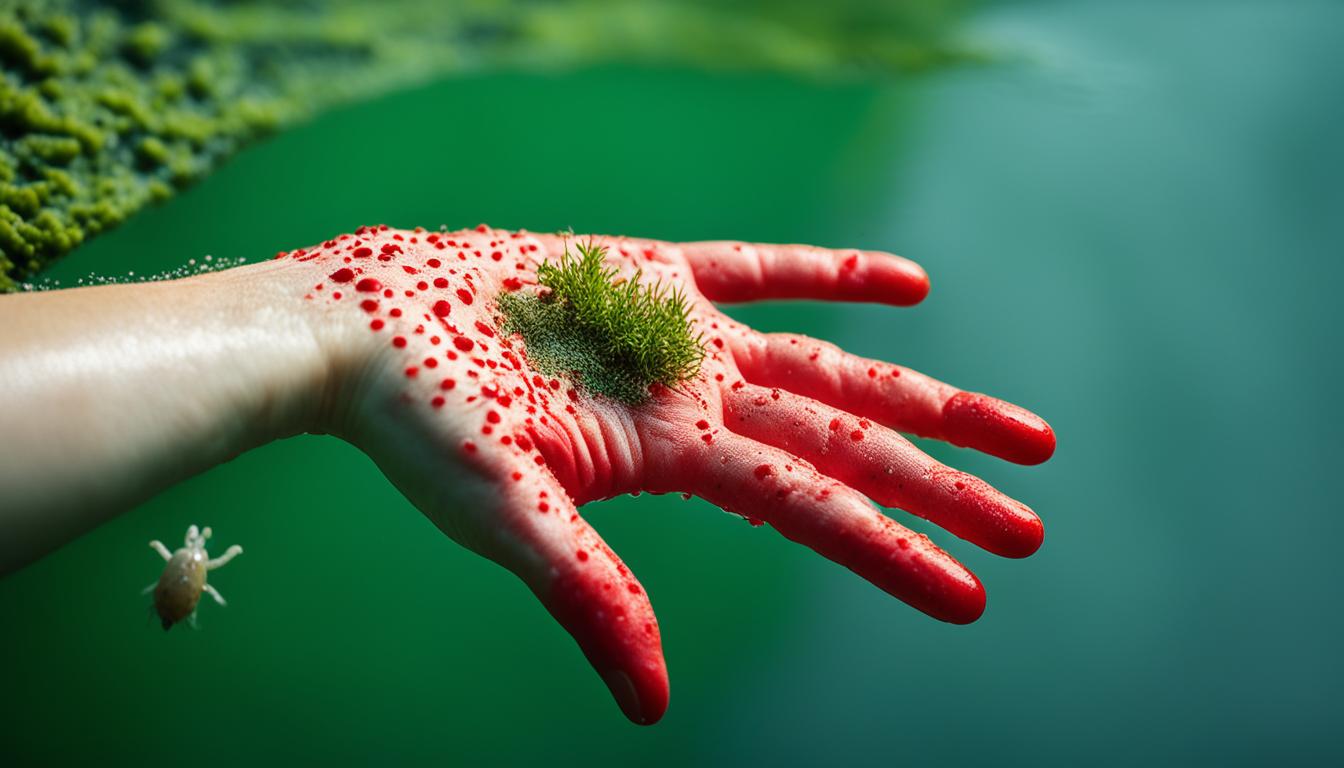Cercarial dermatitis is also called swimmer’s itch. It’s a common disease from contaminated water, caused by avian schistosome larvae. These larvae come from snails in fresh water and can get through human skin. This leads to a rash that makes you itch. The disease is seen mostly in places with lots of migrating birds. It’s key to know the signs, causes, and how to treat cercarial dermatitis to keep it at bay.
Key Takeaways:
- Cercarial dermatitis, also known as swimmer’s itch, is caused by the larvae of avian schistosomes found in freshwater snails.
- It is a water-borne disease that can lead to an itching rash when the larvae penetrate the skin.
- Migratory birds play a role in the spread of cercarial dermatitis.
- Stem cell therapy shows promise in reducing symptoms and promoting healing for cercarial dermatitis.
- Early diagnosis and understanding the causes of cercarial dermatitis are important for effective prevention and treatment.
Causes of Cercarial Dermatitis
Cercarial dermatitis is known as swimmer’s itch. This skin condition comes from avian schistosomes. They’re parasites living in freshwater. These parasites need snails as their first step for reproduction.
The disease is getting more common. Part of the reason is climate change. This affects the number of birds and snails in water. So, more parasites can live and spread.
Migrating birds also spread this disease. They carry the parasites with them. This introduces the disease to new places, including where people live and swim.
To stop cercarial dermatitis, we must look at its causes. Research shows that climate change makes it easier for the disease to spread. Experts can make plans to stop it by understanding bird, snail, and parasite movements.
Teaching people about the risks from the disease is also key. They need to know the dangers of swimming in certain areas. This is especially true near places where birds often stop.
By fighting the reasons behind cercarial dermatitis, we can lower its spread. This can keep more people safe from this sickness.
The Impact of Climate Change
Climate change is making cercarial dermatitis worse. Rising global temperatures and changing weather affect the life cycles of parasites and snails.
These changes create better conditions for parasite growth. This means people are more likely to get sick from the water.
Changes in bird migrations also matter. Birds move differently because of climate change. This can carry parasites to new areas, making more places risky for humans.
Dealing with climate change’s role in the spread of cercarial dermatitis is critical. We can monitor the weather and its effects better. This can help us protect water areas to reduce the disease’s threat.
Symptoms and Diagnosis of Cercarial Dermatitis
Cercarial dermatitis is known as swimmer’s itch. It shows symptoms on the skin. The main sign is an itchy rash. This rash comes with swelling and redness in the area.
These symptoms happen because of an allergy. It occurs when a certain parasite goes into the skin. The parasite is usually in freshwater places. It comes from snails living in these waters.
To diagnose cercarial dermatitis, doctors look at the symptoms. They also ask if the patient has been in places with freshwater. This helps them figure out what caused the issue.
Sometimes, a skin biopsy is needed to be sure. A biopsy involves taking a small skin sample. This sample is checked under a microscope. It shows if the parasite has caused changes in the skin.
Stem Cell Therapy for Cercarial Dermatitis – A Promising Treatment Option
Stem cell therapy is quickly becoming a hopeful solution for cercarial dermatitis. It brings new chances for those looking for effective options. Early results are positive, showing symptom improvement and lessened inflammation.
Using the natural abilities of stem cells, this treatment targets the real causes of the disease. These cells can become many different types, helping to heal damaged tissues. This unique treatment method aims for lasting relief and faster recovery.
Despite the promise, more research is necessary to understand stem cell therapy’s full impact. It’s growing and showing new possibilities for those not helped by usual methods. Stem cell therapy is leading the way towards a future with easier healing for cercarial dermatitis patients.

